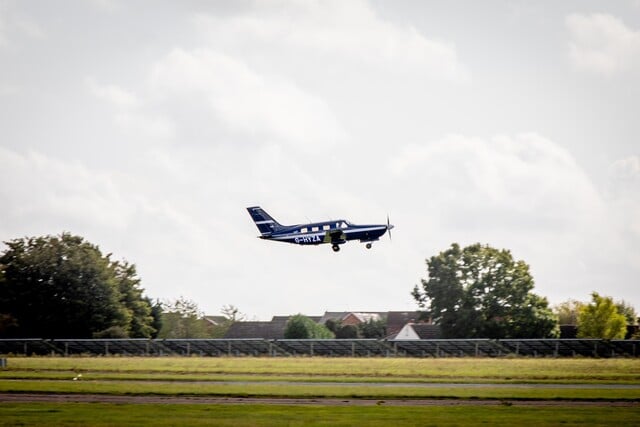Aviation
British Airways sets its sights on world’s first hydrogen-electric fuel cell flight

- British Airways is investing in ZeroAvia to propel its journey towards a zero emissions future
- It comes just weeks after British Airways announced a partnership with ZeroAvia through parent company IAG’s Hangar 51 accelerator programme to explore how hydrogen-powered aircraft can play a leading role in the future of sustainable flying
- Investing in new technologies like zero emissions hydrogen-powered aircraft forms part of the airline’s longer-term plans to achieve net zero carbon emissions by 2050
- ZeroAvia recently completed the world’s first hydrogen-electric fuel cell powered flight of a commercial-grade aircraft as it aims to accelerate the world’s transition to sustainable aviation
British Airways has invested in ZeroAvia – a leading innovator in decarbonizing commercial aviation – in an effort to accelerate the development of 50+ seater aircraft capable of running on zero emissions hydrogen-electric power.
Read more : What Happens When Lightning Strikes an Airplane?
British Airways and a group of investors including Horizons Ventures, Breakthrough Energy Ventures, Ecosystem Integrity Fund, Summa Equity, Shell Ventures, and SYSTEMIQ have invested a total of $24.3m USD, which will enable ZeroAvia to launch a new development programme to further demonstrate the credibility of its technology and accelerate the development of a larger hydrogen-electric engine, capable of flying further and using larger aircraft as soon as 2026.
ZeroAvia says it could achieve commercialisation for its hydrogen-electric power as early as 2024, with flights of up to 500-miles in up to 20-seater aircraft. With this new investment, ZeroAvia expects to have 50+ seat commercial aircraft in operation in five years’ time and it accelerates the company’s vision of powering a 100-seat single-aisle aircraft by 2030.
Read more ; What’s the world’s cheapest international airline?
In September 2020, ZeroAvia achieved the world’s first hydrogen-electric flight of a commercial-grade aircraft. Additionally, the company just completed a ground simulation of the complete power profile for its upcoming first cross-country flight. The ground test demonstrated a full battery shutdown in-flight using the company’s unique fuel cell powertrain configuration, allowing for complete removal of the battery system in the next configuration of the powertrain.
Read More : British Airways’ new Club World Suites business class revealed!

Aviation
COMAC Unveils Plans for the C929 to Rival Airbus and Boeing

After the success of China’s first C919 aircraft, the country is setting its sights on developing a larger plane. COMAC (Commercial Aircraft Corporation of China) has officially confirmed plans to build a widebody aircraft, marking a significant step in its aircraft lineup.
Traditionally, Airbus and Boeing dominate the widebody aircraft market, with decades of expertise in developing planes and engines capable of carrying heavy payloads. China, which currently relies on imported engines, is now aiming to challenge these giants with its own widebody jet, the C929, designed to compete with the Airbus A350 and Boeing 777.
American Airlines Is Looking for Flight Attendants: Apply Now
The C929 will be China’s first independently developed long-range widebody aircraft. It adheres to international airworthiness standards and boasts independent intellectual property rights. The baseline version is designed to seat 280 passengers and offers a range of 12,000 kilometers, catering to global demand for both regional and international air travel.
Russia, which also needs reliable narrowbody and widebody aircraft, could become a key customer for the C929. Additionally, China plans to target the broader Asian market as it continues to expand its aviation capabilities.
Close Call at Heathrow: BA Flight Narrowly Escapes Drone Collision
China’s aviation progress includes the ARJ21 (now called C909), a regional jet with 100 seats for shorter routes, and the C919, a narrowbody jet with 180 seats designed to rival the Boeing 737 MAX and Airbus A320. Both models have found increasing demand in the domestic market.
At China’s largest air show in Zhuhai, COMAC announced that Air China will be the launch customer for the C929 widebody jet, though details about order size and delivery timelines were not disclosed.
Other major deals announced by COMAC include:
- Hainan Airlines: Firm orders for 60 C919 and 40 C909 regional jets.
- Colorful Guizhou Airlines: 30 C909 jets, with 20 firm orders and 10 provisional agreements.
The C929, renamed from the CR929 after Russia withdrew from the joint development project in 2023, is expected to carry 280–400 passengers with a range of 12,000 kilometers, competing directly with Boeing’s 787 Dreamliner.
According to COMAC’s deputy general manager, Tong Yu, the first fuselage section of the C929 is expected by September 2027, with prototype test flights anticipated soon after.
-

 Aviation2 months ago
Aviation2 months agoMicrosoft Flight Simulator Raises $3 Million to Bring Back the An-225 Mriya
-

 Airlines2 months ago
Airlines2 months agoQantas Engineers Stage Walkout Over Cost of Living Concerns
-

 Airlines2 months ago
Airlines2 months agoQatar Citizens Can Travel to the United States Without a Visa
-

 Aviation2 months ago
Aviation2 months agoQatar Airways bans these new Electronic Devices on plane
-

 Airlines2 months ago
Airlines2 months agoJapan Airlines Rolls Out Free Domestic Flights to International Passengers
-

 Defence2 months ago
Defence2 months agoWhich Country Has the Largest Fleet of Fighter Aircraft?
-

 Airport2 months ago
Airport2 months agoWestern Sydney Airport Welcomes Its First Plane After 6 Years of construction
-

 Aviation2 months ago
Aviation2 months agoDid you know ? Once Boeing 747 carried 1088 passenger in 1991









